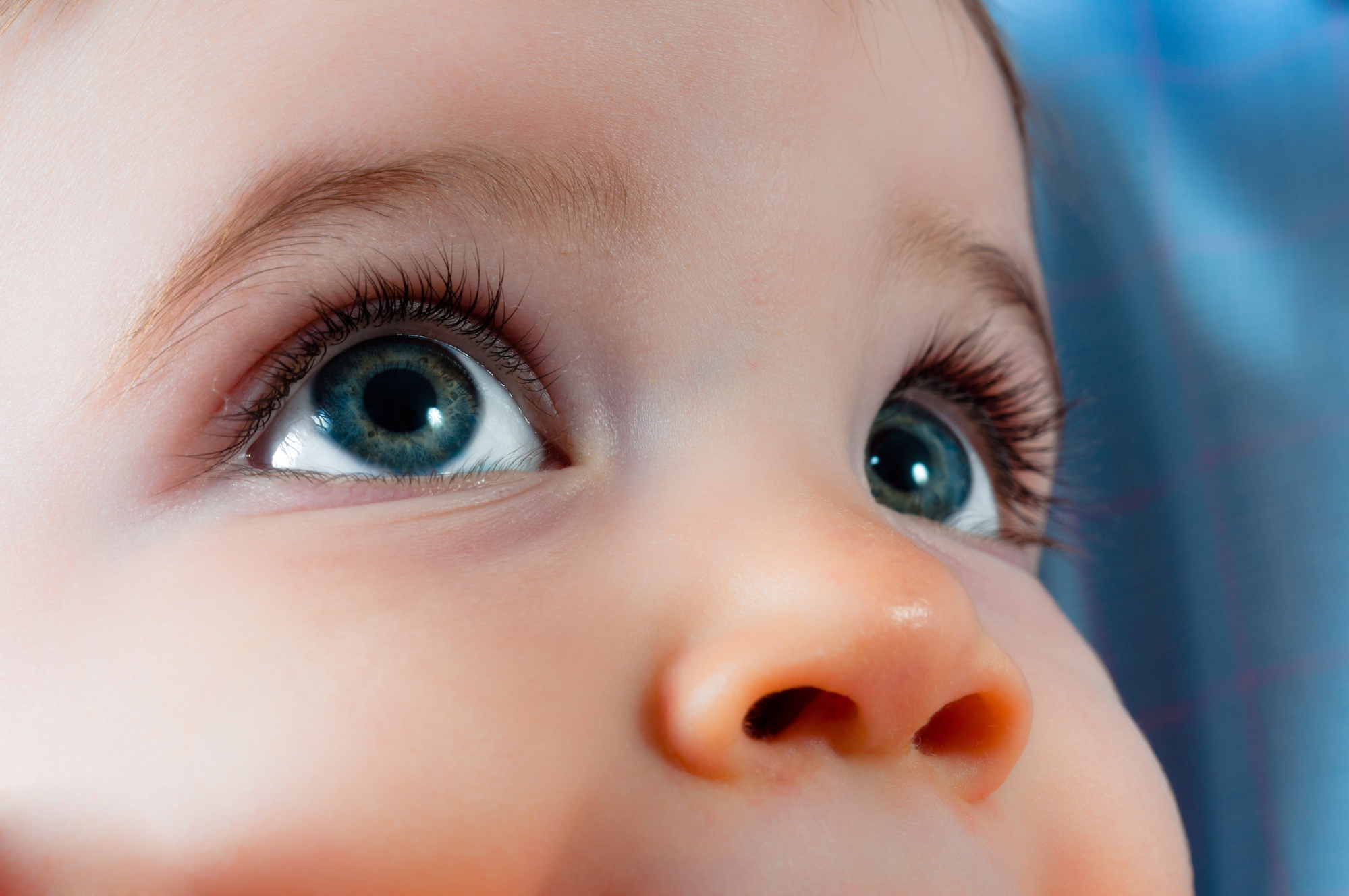Updated on May 1, 2024
When Do Your Eyes Stop Growing?


Vision Center is funded by our readers. We may earn commissions if you purchase something via one of our links.
Babies’ eyes may seem larger than their tiny bodies, so some people assume eyes don’t grow. The truth is, just like all the other body organs, eyes experience growth after birth and even later in life.3 Abnormal eye growth such as axial myopia will require vision correction measures such as glasses or contact lenses.
In this article, we’ll answer the following questions in detail:
- Do eyes grow?
- When do they stop growing?
- How do eyes and vision change over time?
Do Your Eyes Grow?
Yes, eyes grow like every other organ in the body. A newborn baby has eyes about 16.5 millimeters in diameter. Baby eyes grow rapidly in the first two years of life and during puberty.1

Besides physical growth, baby eyes also undergo eye color and visual acuity changes. For example, babies with blue or gray eyes sometimes undergo a change of eye color within 3 to 6 months after birth as the eyes’ melanin production adapts to lighting.
Eyes don’t grow in middle childhood (Ages 6-12). After the first rapid growth (first two years), the second growth spurt occurs during puberty.
Most eyes will attain maximum growth (about 24 millimeters) by early adulthood (20s). If they grow beyond this size, you should be examined by an optometrist.
When Do Your Eyes Stop Growing?
According to the American Optometric Association, the eyes stop growing in your 20s after attaining full growth (about 24 millimeters). Any growth beyond this is considered abnormal.
Lifestyle choices like spending long hours glued to screens can cause the eyeballs to elongate. This type of abnormal growth can affect vision.
However, it’s important to note that the weight of the eyes continues to change over time. This is because the eye lenses continue to grow. According to scientists, the wet weight of the eye increases by 1.38 milligrams per year resulting in slight increases in thickness and diameter.2
Does Vision Fully Develop Along with Eye Growth?
Visual acuity develops alongside eye growth, attaining maximum development by early adulthood.
Neonates have blurry vision and can only perceive light.4 This is the timeline of babies’ visual acuity development:
- First few months of life. Can only focus on objects 8-10 inches in their visual field
- Around 3months. Can focus on an object and follow it as it moves
- Age 2. Depth perception and hand-eye coordination are better; can see objects at close and far range and perceive color
Eye growth and visual abilities undergo another spike of growth during puberty (teenage years). By age 20 or 21, when the eye has fully developed, visual acuity is also at its peak. Any abnormalities are noticeable at this time.
How Do Eyes Change Over Time?
After fully developing, your eyes and vision will stay the same through your 30s. However, it's common to experience changes in your middle ages (40-60 years).
Most adult vision changes are related to the shape of the cornea and the integrity of essential parts of the eye. These include:
- Eyeball elongation (axial myopia). It occurs when the distance from the cornea to the back of the eye is too great for the focusing power of the cornea and lens. Eyeball elongation is caused by extended exposure to phones, TV, and computer screens.
- Cloudy cornea (cataracts). Caused by nutritional deficiencies, eye disease, or environmental factors. A cloudy cornea can lead to vision loss.
- Presbyopia (farsightedness). Caused by loss of lens elasticity as you age, making it difficult to focus on nearby objects. It starts in the mid-40s and worsens until age 65.
- Age-related macular degeneration (AMD). This is the gradual degeneration of the retina’s center (macula). The macula is responsible for sharp vision. Age-related macular degeneration affects about 1 in 10 people and is a leading cause of vision impairment among people aged 60 years and older.
- Loss of peripheral vision. Science indicates that one can experience a 1-3 degree loss of peripheral vision within ten years of life.5 The risk of peripheral vision loss can increase significantly due to glaucoma and age.
- Dry eyes. Although common in all ages, aging eyes are more at risk of drying due to changes in the quality and quantity of their tears.
- Decreased color vision. Retinal cells responsible for color vision decline as you age. This causes colors to become less bright or faded.
Although common, some eye changes can signal serious conditions far from aging. We encourage regular eye exams to check for any abnormalities with your eye structures of vision as your eyes age.
How to Prevent an Elongated Eyeball
To prevent your eyeball from growing too long, do the following:
- Expose your eyes to natural light regularly (at least 2 hours daily)
- Take visual breaks, especially when performing near work, such as reading a book or working in front of a screen
- Use atropine eye drops for children with myopia to slow down axial growth
- Talk to your eye doctor about prescription glasses or contact lenses to protect or restore your eyesight
Why Is One of My Eyes Getting Smaller?
One of your eyes appears to be getting smaller because your upper eyelid is lowered. This can be due to the following:
- Neurological issues like myasthenia gravis cause weakness around the eye muscles
- Excess upper eyelid skin
- Genetic conditions like microphthalmia, where one or both eyeballs are abnormally small
- Weakness and drooping of the forehead
- Sunken eyes due to eye injury or conditions like chronic sinus disease and Bell’s palsy
- Bulging opposite eye due to thyroid eye disease (TED) or abnormal growths
To be confident of what’s causing one eye to appear smaller, you should visit your ophthalmologist for a comprehensive eye exam.
Summary
- Eyes grow like every other organ in the body. The first rapid growth occurs during the first two years of life and the rest during puberty.
- Most eyes reach maximum growth by age 20 or 21 (maximum size of 24 millimeters). Any growth beyond this is abnormal.
- Visual acuity develops alongside eye growth, with both attaining their peak by early adulthood (20s). They stay constant unless compromised by disease, age, or trauma.
- Common eye changes over time include cataracts, eyeball elongation, AMD, decreased color vision, etc.
- If you notice any deviation from normal eye size of vision, consult your eye doctor for professional advice. Your doctor will recommend appropriate treatment if necessary.
In this article
6 sources cited
Updated on May 1, 2024
Updated on May 1, 2024
About Our Contributors
Vincent Ayaga is a medical researcher and seasoned content writer with a bachelor's degree in Medical Microbiology. Specializing in disease investigation, prevention, and control, Vincent is dedicated to raising awareness about visual problems and the latest evidence-based solutions in ophthalmology. He strongly believes in the transformative power of ophthalmic education through research to inform and educate those seeking knowledge in eye health.
Dr. Melody Huang is an optometrist and freelance health writer with a passion for educating people about eye health. With her unique blend of clinical expertise and writing skills, Dr. Huang seeks to guide individuals towards healthier and happier lives. Her interests extend to Eastern medicine and integrative healthcare approaches. Outside of work, she enjoys exploring new skincare products, experimenting with food recipes, and spending time with her adopted cats.

